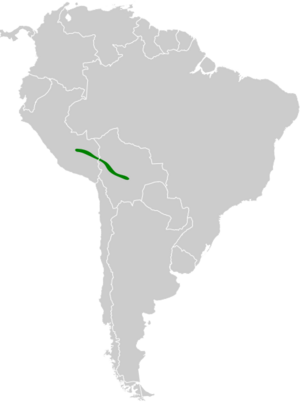Yellow-rumped antwren facts for kids
Quick facts for kids Yellow-rumped antwren |
|
|---|---|
| Conservation status | |
| Scientific classification | |
| Genus: |
Euchrepomis
|
| Species: |
sharpei
|
 |
|
| Synonyms | |
|
Terenura sharpei |
|
The yellow-rumped antwren (Euchrepomis sharpei) is a small bird. It is a type of "typical antbird". This bird is found in the countries of Bolivia and Peru. Scientists consider it a Near Threatened species. This means its numbers are going down, but it is not yet in immediate danger.
Contents
About the Yellow-rumped Antwren
How Scientists Name Birds
The yellow-rumped antwren was first described in 1901. A German bird expert named Hans von Berlepsch gave it its first scientific name, Terenura sharpei. Later, in 2012, scientists studied its family tree. They decided to move it to a new group, or genus, called Euchrepomis. This bird is the only species in its group.
What the Bird Looks Like
The yellow-rumped antwren is a small, slim bird. It is about 9.5 to 10.5 centimeters (3.7 to 4.1 inches) long. It weighs around 7 to 8 grams (0.25 to 0.28 ounces). It has a thin beak and a fairly long tail.
Male and female yellow-rumped antwrens look different.
- Males have a pale gray face with a dark line through their eye. Their head and neck are black. Their back is olive green, and their lower back and rump are bright yellow. Their tail is grayish olive. Their wings have blackish-gray feathers with yellow tips. These tips create two yellow stripes when the wings are folded. Their throat and chest are pale gray, turning more yellow on their belly.
- Females have an olive-brown head, neck, and eye line. They have a gray stripe above their eye. Their wings are dull olive-brown, with only a hint of yellow. Their lower back and rump are more olive-yellow than the males'.
Both male and female birds have dark eyes. Their upper beak is black or dark gray. Their lower beak is pale gray. Their legs and feet are dark gray or blue-gray.
Where the Bird Lives
The yellow-rumped antwren lives in the Yungas region. This area is on the eastern side of the Andes mountains. You can find it in southeastern Peru and western Bolivia. It lives in places like Manu National Park in Peru. It is also found in parts of Bolivia, including areas in the La Paz and Cochabamba departments.
This bird prefers to live in cloud forests. These are forests high in the mountains where clouds often cover the trees. It likes the tall trees in untouched forests. It usually lives at heights between 1,100 and 1,680 meters (3,600 and 5,500 feet) above sea level. Sometimes, it can be found as low as 750 meters (2,460 feet).
Yellow-rumped Antwren Behavior
Movement
The yellow-rumped antwren does not migrate. It stays in the same area all year long.
Feeding Habits
This bird eats arthropods, which are small bugs and insects. We don't know all the details of its diet. It usually hunts for food in pairs. Sometimes, small family groups are seen. It almost always joins large groups of different bird species that feed together. The antwren looks for food high up in the treetops. It moves quickly and skillfully through thick leaves and vines.
Reproduction
Scientists do not know much about how the yellow-rumped antwren reproduces. It seems to breed during the rainy season, which starts in November. The birds are very noisy and protective of their territory from June to December.
Vocalization
The yellow-rumped antwren has a special song. It starts with notes that get higher in pitch and shorter in length. Then, it quickly becomes a high-pitched trill with many notes. Another sound it makes is a sweet tsyu call.
Status and Conservation
The IUCN (International Union for Conservation of Nature) keeps track of how threatened animals are. In 1988, they first listed the yellow-rumped antwren as Threatened. Then, it was listed as Vulnerable in 1994, and Endangered in 2000. But in late 2022, its status improved to Near Threatened.
This bird lives in a very small area. Its population is estimated to be between 2,500 and 10,000 adult birds. This number is believed to be shrinking. People are clearing forests where the bird lives to grow crops. These crops include coffee, citrus fruits, coca, and tea. However, large areas of untouched forest still exist in its range. Even though some trees are being cut down, the overall loss of forest cover is still low.
The yellow-rumped antwren is known to live in Manu National Park. This park helps protect the birds and their home. There might be other protected areas where it lives, but scientists are not sure yet.


